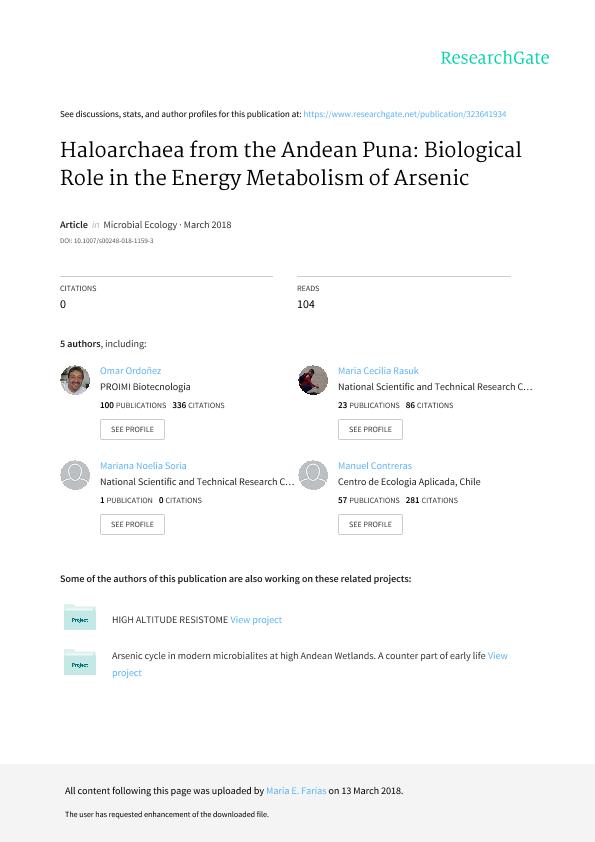Artículo
Haloarchaea from the Andean Puna: Biological Role in the Energy Metabolism of Arsenic
Ordoñez, Omar Federico ; Rasuk, Maria Cecilia
; Rasuk, Maria Cecilia ; Soria, Mariana Noelia; Contreras, Manuel; Farias, Maria Eugenia
; Soria, Mariana Noelia; Contreras, Manuel; Farias, Maria Eugenia
 ; Rasuk, Maria Cecilia
; Rasuk, Maria Cecilia ; Soria, Mariana Noelia; Contreras, Manuel; Farias, Maria Eugenia
; Soria, Mariana Noelia; Contreras, Manuel; Farias, Maria Eugenia
Fecha de publicación:
10/2018
Editorial:
Springer
Revista:
Microbial Ecology
ISSN:
0095-3628
Idioma:
Inglés
Tipo de recurso:
Artículo publicado
Clasificación temática:
Resumen
Biofilms, microbial mats, and microbialites dwell under highly limiting conditions (high salinity, extreme aridity, pH, and elevated arsenic concentration) in the Andean Puna. Only recent pioneering studies have described the microbial diversity of different Altiplano lakes and revealed their unexpectedly diverse microbial communities. Arsenic metabolism is proposed to be an ancient mechanism to obtain energy by microorganisms. Members of Bacteria and Archaea are able to exploit arsenic as a bioenergetic substrate in either anaerobic arsenate respiration or chemolithotrophic growth on arsenite. Only six aioAB sequences coding for arsenite oxidase and three arrA sequences coding for arsenate reductase from haloarchaea were previously deposited in the NCBI database. However, no experimental data on their expression and function has been reported. Recently, our working group revealed the prevalence of haloarchaea in a red biofilm from Diamante Lake and microbial mat from Tebenquiche Lake using a metagenomics approach. Also, a surprisingly high abundance of genes used for anaerobic arsenate respiration (arr) and arsenite oxidation (aio) was detected in the Diamante’s metagenome. In order to study in depth the role of arsenic in these haloarchaeal communities, in this work, we obtained 18 haloarchaea belonging to the Halorubrum genus, tolerant to arsenic. Furthermore, the identification and expression analysis of genes involved in obtaining energy from arsenic compounds (aio and arr) showed that aio and arr partial genes were detected in 11 isolates, and their expression was verified in two selected strains. Better growth of two isolates was obtained in presence of arsenic compared to control. Moreover, one of the isolates was able to oxidize As[III]. The confirmation of the oxidation of arsenic and the transcriptional expression of these genes by RT-PCR strongly support the hypothesis that the arsenic can be used in bioenergetics processes by the microorganisms flourishing in these environments.
Archivos asociados
Licencia
Identificadores
Colecciones
Articulos(PROIMI)
Articulos de PLANTA PILOTO DE PROC.IND.MICROBIOLOGICOS (I)
Articulos de PLANTA PILOTO DE PROC.IND.MICROBIOLOGICOS (I)
Citación
Ordoñez, Omar Federico; Rasuk, Maria Cecilia; Soria, Mariana Noelia; Contreras, Manuel; Farias, Maria Eugenia; Haloarchaea from the Andean Puna: Biological Role in the Energy Metabolism of Arsenic; Springer; Microbial Ecology; 76; 3; 10-2018; 695-705
Compartir
Altmétricas



